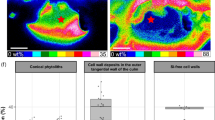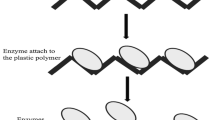Abstract
The catagenesis of organic matter (OM) was modeled by the hydrous pyrolysis of a Riphean mudstone. Microscopic observations of the processes operating during kerogen heating to 600°C were conducted in a diamond anvil cell. The results of pyrolysis in an aqueous environment were used to calculate the activation energies of kerogen cracking and derive chemical kinetic models for OM catagenesis. Isothermal experiments were carried out for 3 days at temperatures of 300, 310, …, 360, and 370°C. The maximum bitumen yield was obtained at 330°C followed by thermal cracking at higher temperatures. The aromatic and saturated hydrocarbons from rock bitumen, hydrous pyrolyzates, and kerogen flash pyrolyzates were analyzed by chromatography-mass spectrometry. We also discuss the problem of extrapolation of high-temperature pyrolysis results to geologic observations under the conditions of regional catagenesis.
Similar content being viewed by others
References
V. N. Melenevsky, A. E. Kontorovich, Wuu-Liang Huang, A. I. Larichev, T.A. Bul’bak “Hydrothermal Pyrolysis of Organic Matter in Riphean Mudstone,” Geochem. Int. 47, 476–484 (2009).
T. Barth, B. J. Schmidt, and S. B. Nielsen, “Do Kinetic Parameters from Open Pyrolysis Describe Petroleum Generation by Simulated Maturation,” Bull. Canadian Petrol. Geol 44, 446–457 (1996).
G. Lis, M. Mastalerz, A. Schimmelmann, and M. D. Lewan, “FTIR Absorption Indicesfor Thermal Maturity in Comparison with Vitrinite Reflectance Roin Type-II Kerogens from Devonian Black Shales,” Org. Geochem. 36, 1533–1552 (2005).
Serban C. Moldoveanu, Analytical Pyrolysis of Natural Organic Polymers (Elsevier, Amsterdam, New York, 1998).
A. E. Kontorovich, Geochemical Methods of Quantitative Prediction of the Oil and Gas Potential (Nedra, Moscow, 1976) [in Russian].
T. I. Eglinton and A. G. Douglas, “Quantitative Study of Bio-Marker Hydrocarbons Released from Kerogens During Hydrous Pyrolysis,” Energy Fuels 2, 81–88 (1988).
M. Radke, D. H. Welte, and H. Willsch, “Geochemical Study on a Well in the Western Canada Basin: Relation of the Aromatic Distribution Pattern to Maturity of Organic Matter,” Geochim. Cosmochim. Acta 46, 1–10 (1982).
H. Amijaya, J. Schwarzbauer, and R. Littke, “Organic Geochemistry of the Lower Suban Coal Seam, South Sumatra Basin, Indonesia: Palaeoecological and Thermal Metamorphism Implications,” Org. Geochem. 37, 261 (2006).
K. E. Peters and J. M. Moldowan, The Biomarker Guide: Interpreting Molecular Fossils in Petroleum and Ancient Sediments (Prentice Hall, Englewood Cliffs, 1993).
B. P. Tissot and J. Espitalie, “L’Evolution Thermique De La Matiere Organique Des Sediments, Application D’Une Simulation Mathematique,” Rev. Inst. Franc. du Petrole 30, 743–777 (1975).
Tissot, B. and Welte, D., Petroleum Formation and Occurrence, (Springer, Heidelberg, 1978).
A. K. Burnham and J. J. Sweeney, “A Chemical Kinetic Model of Vitrinite Maturation and Reflectance,” Geochim. Cosmochim. Acta 53, 2649–2657 (1989).
D. W. Waples and R. G. Marzi, “The Universality of the Relationship Between Vitrinite Reflectance and Transformation Ratio,” Org. Geochem. 28, 383–388 (1998).
J. J. Sweeney and A. K. Burnham, “Evaluation of a Simple Model of Vitrinite Reflectance Based on Chemical Kinetics,” Am. Ass. Petrol. Geol. Bull. 74, 1559–1570 (1990).
A. S. Mackenzie and D. P. McKenzie, “Isomerisation and Aromatization of Hydrocarbons in Sedimentary Basins Formed by Extension,” Geol. Mag. 120, 417–470 (1983).
N. V. Lopatin, “Temperature and Geological Time as the Factors of Coalification,” Izv. Akad. Nauk SSSR, Ser. Geol., No. 3, 95–106 (1971).
N. V. Lopatin, “Historical-Genetic Analysis of Petroleum Formation Using Models of Continuous Subsidence of Oil-Source Bed,” Izv. Akad. Nauk SSSR, Ser. Geol., No. 8, 93–101 (1976).
N. V. Lopatin, Formation of Fossil Fuels (Nedra, Moscow, 1983) [in Russian].
A. E. Kontorovich and V. N. Melenevsky, “The Theory of the Main Stage of the oil Generation and its Place in the Sedimentary-Migration Theory of Naphthide Generation,” Izv. Akad. Nauk SSSR, Ser. Geol., No. 1, 3–13 (1988).
Basin Mod 1-D for WindowsTM, Version 5.4 Software, A Basin Analysis Modelling System by Platte River Associates (Denver, 1995).
L. R. Snowdon, “Errors in Extrapolation of Experimental Kinetic Parameters To Organic Geochemical Systems,” AAPG Bull. 63, 1128–1133 (1979).
M. S. Zakhar’evskii, Kinetics of Chemical Reaction, (Leningr. Gos. Univ., Leningrad, 1959) [in Russian].
A. K. Burnham, Relationship between Hydrous and Ordinary Pyrolysis Lawrence Livermore National Laboratory Report UCRL-JC-114130 (1993).
A. K. Burnham, “Comments on “Experiments on the Role of Water in Petroleum Formation” by M.D. Lewan, Geochim. Cosmochim. Acta 62, 2209–2212 (1998).
A. K. Burnham, R. L. Braun, H. R. Greg, and A. M. Samou, “Comparison of Methods for Measuring Kerogen Pyrolysis Rates and Fitting Kinetic Parameters,” Energy Fuels 1, 452–458 (1987).
J. Espitalie, “Thermal Cracking of Kerogen in Open and Closed Systems: Determination of Kinetic Parameters and Stoichiometric Coefficients for Oil and Gas Generation,” Org. Geochem. 26, 321–339 (1997).
M. D. Lewan, “Experiments on the Role of Water in Petroleum Formation,” Geochim. Cosmochim. Acta 61, 3691–3723 (1997).
K. Rajeshwar and J. Dubow, “On the Validity of a First-Order Kinetic Scheme for Thermal Decomposition of Oil Shale Kerogen,” Thermochim. Acta 54, 71–85 (1982).
Author information
Authors and Affiliations
Corresponding author
Additional information
Original Russian Text © V.N. Melenevskii, 2012, published in Geokhimiya, 2012, Vol. 50, No. 5, pp. 470–482.
Rights and permissions
About this article
Cite this article
Melenevskii, V.N. Modeling of catagenetic transformation of organic matter from a Riphean mudstone in hydrous pyrolysis experiments: Biomarker data. Geochem. Int. 50, 425–436 (2012). https://doi.org/10.1134/S001670291203007X
Received:
Accepted:
Published:
Issue Date:
DOI: https://doi.org/10.1134/S001670291203007X




